On August 6th, 1819, Norwich University was founded by Captain Alden Partridge as the “American Literary, Scientific, and Military Academy.” As a university that prides itself on its diverse array of academic paths, and strong emphasis on literary education, it is unsurprising that for much of its existence, Norwich has been home to assorted student publications. These have included newspapers, literary journals, and a mixture of the two. They have been founded by secret societies and those wishing to create a place for student’s creativity to be displayed. Some only lasted a year or two while others are pillars of Norwich’s literary tradition as they have stood for decades. This is a history of Norwich University’s student publications.

The first Norwich student publication was established thirty-four years after the founding of the school, in 1853. The University Regulator had truly secretive beginnings. The cadet-founded newspaper first appeared in 1853 and was run by the Regulators, a secret student society founded on the Norwich campus. As is the nature of secret societies, their rituals were kept veiled from outsiders so not much is known about the Regulators, but they did hold regular initiation rituals for their new members. The University Regulator served as a means for The Regulators to publish pieces that supported their values and ideas about how university students and faculty should conduct themselves.
The motto of the Regulators was “Justice to whom Justice is due”, and this was featured on the front page of the paper directly under the name Regulator. The Regulators wanted to send a message with their publication and did so despite the irregular publication of the paper. The paper sold many copies on campus and commanded great interest from both faculty and students. However, the articles and pieces in the paper that commented on the administration of the school and the campus caused consternation from authority figures in the university’s leadership. The Regulators published the last issue of the paper in 1856 but not before the controversial paper had caused enough disturbance for other students to create a paper that countered The Regulator.
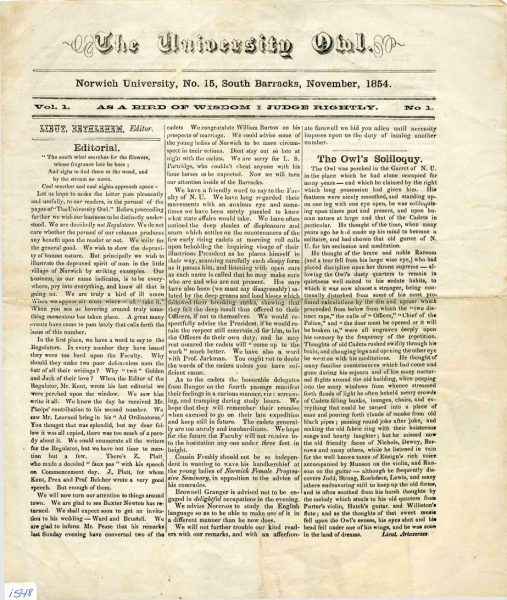
The publication founded in response to the Regulator was the University Owl. Established in 1854, the paper’s editors were in opposition to the opinions published in The Regulator. The Owl only published two editions and the last one was published in 1856, once again highlighting the fact that its main purpose was to comment on The Regulator.
With the demise of the Regulator and the Owl, it was four years until Norwich University saw another student publication. In 1860, Captain Charles Curtis ‘61 and Admiral George Converse ’63 established the Reveille. The first edition of this new paper was published in April of 1860 as the American Civil War was beginning. Interestingly, like the Regulator, the Reveille was started by a student organization. In this case, it was members of the Parthenon Society and Theta Chi Fraternity. From 1862 to 1865, the paper was edited and published by members of the junior class, but publication was halted for four years in 1865.
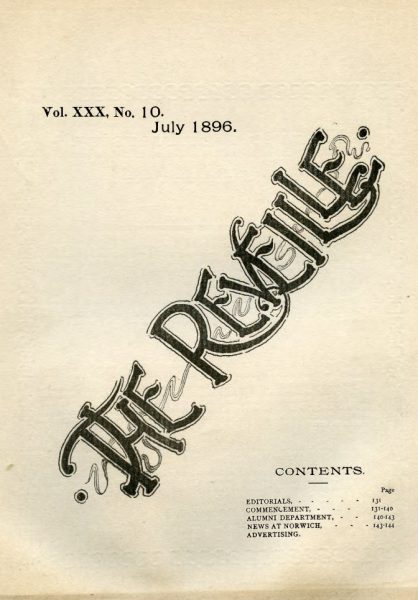
The paper picked back up in April 1869 when Captain Curtis began publishing the paper again. The contents of the Reveille during this time included university sketches, topics relating to the military education received at Norwich, work the university was undertaking, and articles and stories on cadet life.
The Reveille was published regularly from 1869 until 1876 when publication was once again halted. In 1881 the paper was reinstated and published under the guidance of the Corps of Cadets as a whole, meaning that it was truly a student newspaper run by a team of students from across campus, not just a select society or organization.
The first edition of the rejuvenated Reveille came out in January of 1882. This time the topics published were divided into distinct categories. The Reveille published sections including editorials, literary reviews, personal work of students, college and campus news and events, and a general contributions section. While the paper was vibrant during this period, it was put on hold again from 1885 through 1886. After this, the next edition was released in January 1887, and the paper underwent another evolution. At this time, the paper became an official publication for the Vermont National Guard. The Reveille published articles and news relating to the activities of the guard along with content similar to earlier iterations of the paper.
In 1891, the Reveille severed its ties with the Vermont National Guard and returned to publishing content like it had during the 1880s. In 1908, the Reveille became a reprint of the Northfield News. To bring back its Norwich-related articles, revitalize the Reveille, and revitalize university publications in general, the Norwich University Journalists’ Association was established in 1909. The goal of the association was to inspire literary work by students, create a more cohesive Norwich community by uniting students, alumni, and faculty, as well as to help student-run publications become more uniform and create more professional appearances.
While The Reveille went through many phases during its 54 years, it closed its doors for good in 1923.
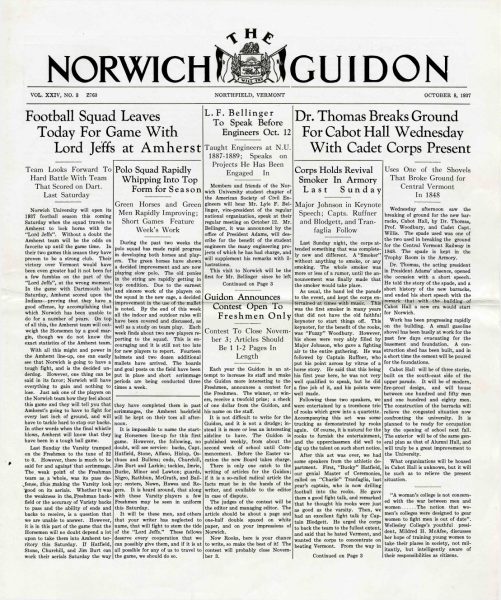
While this is a history of publications that led to The Chameleon, it is worth mentioning that the Guidon was established in 1922. It became the official undergraduate newspaper of Norwich University and was published on a bi-weekly basis by a cadet staff with a faculty advisor. Because the Guidon published articles on cadet sports, and campus news and events, it opened the door for other student publications to focus on creative genres such as poetry, creative writing, and short stories submitted by students. The Guidon continues today.
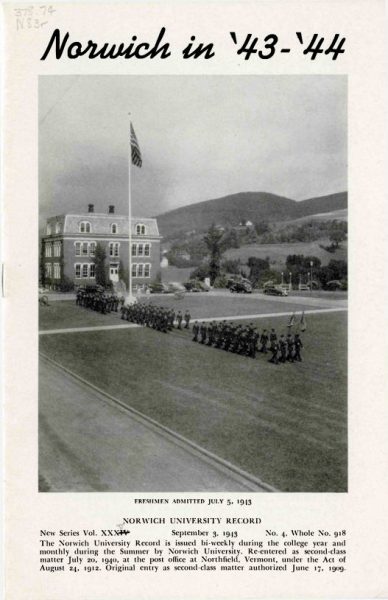
The next publication in the lineage of student publications related to the Chameleon was the University Record, which was established in 1907. For its first two years of existence, it released editions in June, August, October, and December each year. In 1909, it began publishing weekly. In its first two years, content included general information on the university, commencement reports, regulations for the government of Norwich, and librarian reports. However, soon after it became a weekly publication it became a reprint of the Northfield News, much like the Reveille had. It seems that this is how student publications die at Norwich as the University Record faded out in 1909 after this.

In 1951, Norwich’s first true literary journal, the Magnum, was established. The Magnum was a first for Norwich as the survival of the publication relied on students buying their copy of the journal before it had ever been printed. This was done because the school offered no financial support to the journal, so its editors had to accumulate the funds to print the journal ahead of time and those who had bought a copy would get their issues once it had been completed.
The first pre-orders of the magazine were available for purchase in December 1951. The Magnum typically published all submitted work as long as it fit the journal’s content criteria of short stories, comedy, poetry, sports pieces, and literary reviews. In addition to these common themes, they also published stories on Norwich alumni and benefactors of the school. The Magnum met with success with its first printed issues in 1951 and got approved for financial support by the Norwich Non-Athletic Counsel in 1952. This journal lost steam in 1953 and publication was stopped.

Another more obscure and tangential ancestor of the Chameleon was yearly magazines known as ring books. While the Norwich University Archives are unsure of when publication of ring books began or ended, the Norwich University Archives has examples from 1958, 1961-1968, and 1970-1972. According to Gail Wiese, Norwich University archivist, “The Guidon during that time reported that ring books were circulated right before Junior Week festivities began.”
While there aren’t many literary features that overlap with the Chameleon, ring books offer a story about that year’s ring design, portraits of cadets’ dates to the Junior Week social event, and extensive lewd humor.
According to Wiese, “Ring books were an outgrowth of the Junior Week (later Junior Weekend) social event at Norwich, particularly in the 1960s and 1970s. All our examples are closely tied to Junior Week and the Junior Ring.” Wiese continued, “The Archives don’t have a full picture of ring books’ publication history. They tend to be a little confusing to date as many were named or identified by the class year of the juniors (as the class that published them) rather than the year they were published. They were pretty ephemeral items but based on our examples, I suspect they likely petered out sometime in the 1970s.”
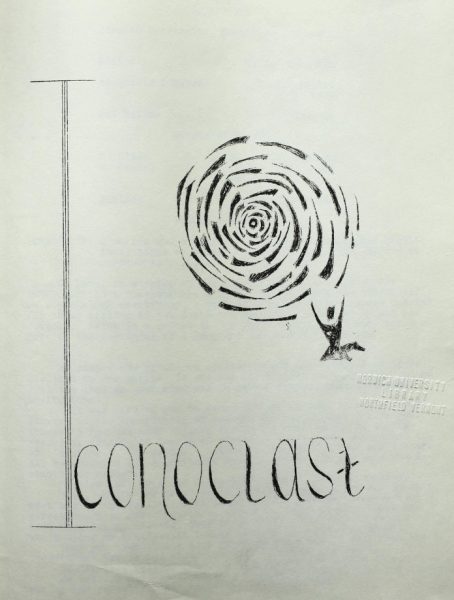
An extremely short-lived Norwich publication was the Iconoclast, which was in circulation from 1960 to 1961. This journal published short stories, poems, and creative writing pieces like science fiction.
The most recent and longest-running Norwich University student literary journal is The Chameleon. This journal filled the gap that The Magnum and The Iconoclast had left when these publications were halted in 1953 and 1961, respectively. The first issue of The Chameleon was published in 1962. Because the Chameleon has an extensive history, it provides us with a unique example of how American cultural progressions and historical events have affected the content of the journal. Also, the Chameleon offers insight into what Norwich students were writing about during this period from 1960 to 2020.
During the 1960s, the Chameleon published poems, short stories, and creative essays that related to war, loss, and family. Additionally, the journal published pieces on cadet life, some Polynesian art, and even a poem about a cadet marching tours.

As America, Norwich, and the Chameleon transitioned into the 1970s, the changes occurring in our country were visible in the journal. The journal continued to publish poems, short stories, and creative pieces, however, the topics and tone of these pieces changed as American views on the Vietnam War, racial issues, and women’s rights began to change.
During this period, the journal was published in a simple format. The art published in the journal primarily comprised of sketches and black-and-white photographs.
The 1980s once again brought change to the Chameleon as the open discussion of sexual activity, drug use, cultural issues, and more progressive topics became more socially acceptable.
In this writer’s opinion, the most interesting and darkest period in the Chameleon’s history was the late 1990s and the 2000s. The journal kept its simple cover designs, featuring a chameleon lizard with slight variations to the color scheme from 2000 to 2005. These issues were short, at about thirty pages including artwork and literary pieces. The artwork in particular provided dark visuals and gave the journal a sense of grunge, no doubt a response to American culture in the late 1990s and early 2000s. The artwork was primarily black and white using pencil or what appeared to be charcoal sketches of the Vietnam era and Global War on Terror (GWOT) GIs smoking cigarettes, ominous drawings of a dark mounted knight, and even a skateboarder.
Literary topics at this time included love, war, loss, personal image discussions relating to race, sex, the identity attending a military college created, and personal growth.
Issues from the late 2000s shared literary pieces about soldiers’ experiences in Iraq and Afghanistan, alcoholism, domestic violence, women’s rights in America and around the globe, law enforcement, and relationships. These pieces were emotional and moving and highlighted the major cultural and political events and issues during this period.
In a journal from the early 2010s, a particularly interesting piece was titled “Don’t Believe CNN.” It appeared to have been written by a person of color, and it very clearly attacked the mainstream media and American government for aiding in the creation of stereotypes and social conditions that oppressed and adversely affected people of color. Additionally, the author of this piece also commented on the effect media has on the personal images of young women, people of color, and American youth in general. The writer demanded answers.
In this period, pieces that once again highlighted the dark tone of the Chameleon included photos of large groups of cadets on the tour strip, no doubt indicative of the particularly intense nature of corps culture at this time. Also, a piece speaking about internal rage and noting the existence of a “guardian demon” was very dark.
As noted earlier, pieces on veteran’s experiences in the Global War on Terror were common and openly critical of the Bush and Obama administrations for America’s involvement overseas. These pieces spoke specifically about losing friends in combat in Iraq and Afghanistan.
Beginning in 2010, the Chameleon started to make each issue of the journal more unique, featuring different cover designs each year. For instance, the 2010 cover was abstract, the 2011 edition featured a griffin, and the 2012 issue hosted a manila envelope with a stamp reading “censored.”
In 2012, the Chameleon reshaped itself. First, the design of the journal transitioned from saddle stitching (where the journal is held together with staples from the outside to the centermost page) to perfect bound (where pages are glued at the spine). The Chameleon also embraced graphic design elements to make the journal more colorful and artistic.
During these years, the Chameleon also created new prizes: the Robert Halleck Poetry Prize, the Allan Nason Prize, the Chameleon Prose Prize, and the Be You, Be True (LGBTQ+) Prize.
Content during this period continued to focus on loss, love, war, and Corps life, but it was also influenced by society’s evolution as topics that dealt with people of color and the LGBTQ+ community became more prominent.
Researching and writing about this incredible progression of publications at Norwich has been an enlightening experience and has demonstrated drastic changes in Norwich and American culture and what has captured and fueled the thoughts and creative endeavors of Norwich students for two hundred years!
To search the Norwich Archives for these literary journals, go to this link: https://archives.norwich.edu/digital/custom/digitalcollections
